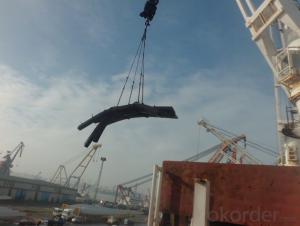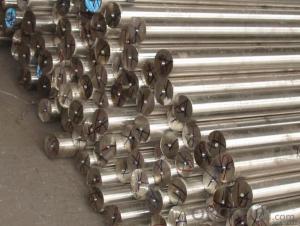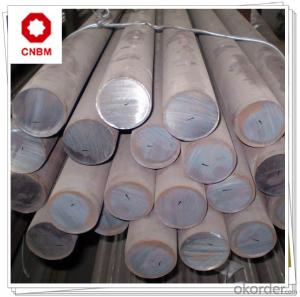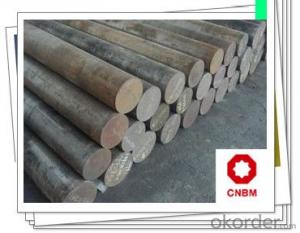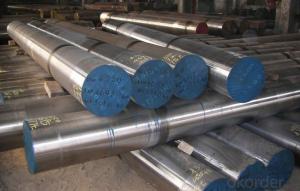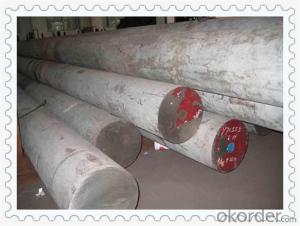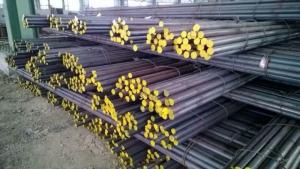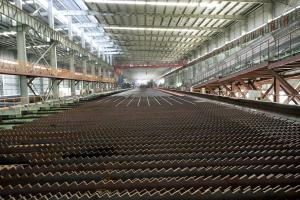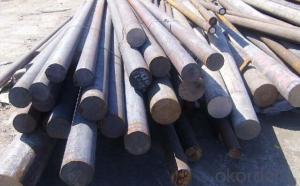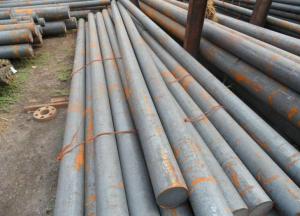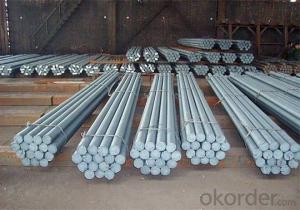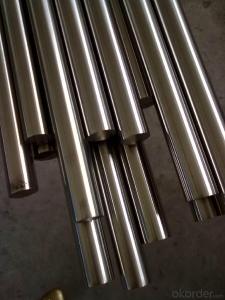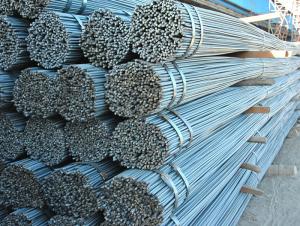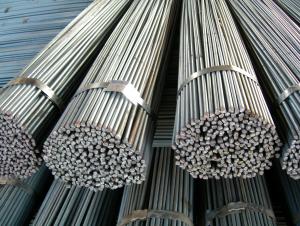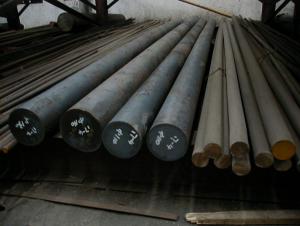Hot Rolled Round Carbon Steel Bar
- Loading Port:
- China Main Port
- Payment Terms:
- TT or LC
- Min Order Qty:
- -
- Supply Capability:
- -
OKorder Service Pledge
OKorder Financial Service
You Might Also Like
Product Description:
OKorder is offering Round Bar at great prices with worldwide shipping. Our supplier is a world-class manufacturer of steel, with our products utilized the world over. OKorder annually supplies products to European, North American and Asian markets. We provide quotations within 24 hours of receiving an inquiry and guarantee competitive prices.
Product Applications:
1. Hot rolled round bar of 6-25mm, or small round is mostly used for straight bundles supply, and used for steel, bolts and various mechanical parts. While the bigger round bar, or more than 25mm hot rolled bar, is mainly for the manufacture of mechanical parts or for seamless steel billet.
2. Besides, we can supply some especial material steel round bar that can be used for main shaft of steamer, hummer shank, with big section and supper force.
Product Advantages:
OKorder's Round Bar are durable, strong, and resist corrosion.
Main Product Features:
· Premium quality
· Prompt delivery & seaworthy packing (30 days after receiving deposit)
· Corrosion resistance
· Can be recycled and reused
· Mill test certification
· Professional Service
· Competitive pricing
Product Specifications:
1. Grade: Q195, Q235, Q345
2. Diameter: 6mm-150mm
3. Length: 6m, 9m, 12m or as customer’s request
4. Tolerance: Within ±5% for weight; ±2mm for diameter
5. Note: The price can be better is the quantity is good
6. Chemical composition
Alloy No | Element (%) | ||||
C | Mn | S | P | Si | |
Q195 | 0.06-0.12 | 0.25 | ≤0.05 | ≤0.045 | ≤0.3 |
Q235 | 0.12—0.20 | 0.3—0.7 | ≤0.045 | ≤0.045 | ≤0.3 |
Q345 | ≤0.2 | 1.00-1.60 | ≤0.045 | ≤0.045 | ≤0.55 |
Payment:
-Invoicing on theoretical weight or actual weight a s customer’s request.
-FOB, CFR or CIF.
-Regular terms of payment:
1, 30% payment in advance, the remaining balance (70% payment) against the copy of B/L.
2, 30% payment in advance, the remaining balance (70% L/C) against the copy of B/L.
3, Negotiable.
FAQ:
Q1: Why buy Materials & Equipment from OKorder.com?
A1: All products offered byOKorder.com are carefully selected from China's most reliable manufacturing enterprises. Through its ISO certifications, OKorder.com adheres to the highest standards and a commitment to supply chain safety and customer satisfaction.
Q2: How do we guarantee the quality of our products?
A2: We have established an advanced quality management system which conducts strict quality tests at every step, from raw materials to the final product. At the same time, we provide extensive follow-up service assurances as required.
Q3: How soon can we receive the product after purchase?
A3: Within three days of placing an order, we will begin production. The specific shipping date is dependent upon international and government factors, but is typically 7 to 10 workdays.
Q4: What makes stainless steel stainless?
A4: Stainless steel must contain at least 10.5 % chromium. It is this element that reacts with the oxygen in the air to form a complex chrome-oxide surface layer that is invisible but strong enough to prevent further oxygen from "staining" (rusting) the surface. Higher levels of chromium and the addition of other alloying elements such as nickel and molybdenum enhance this surface layer and improve the corrosion resistance of the stainless material.
Images:

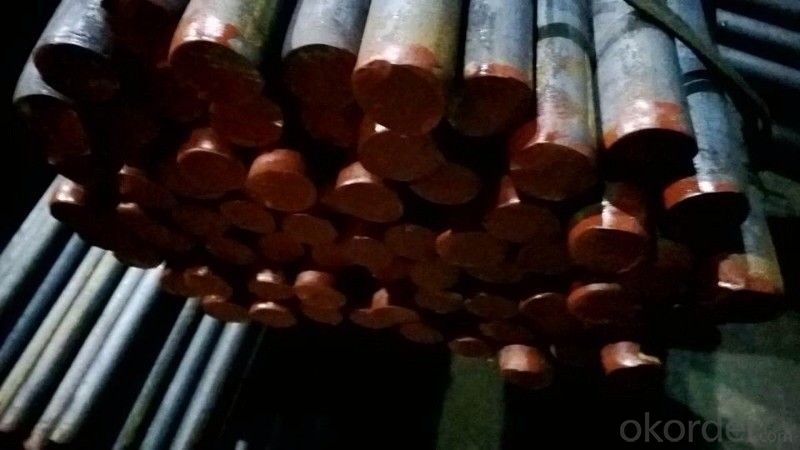
- Q: How do steel round bars compare to brass round bars?
- Steel round bars and brass round bars possess distinct characteristics that make them suitable for different purposes. To begin with, steel round bars exhibit superior strength and durability in comparison to brass round bars. Steel boasts a higher tensile strength, rendering it ideal for applications demanding resistance against heavy loads. Consequently, it finds extensive usage in the construction, manufacturing, and automotive sectors, where strength and durability play pivotal roles. On the other hand, brass round bars are renowned for their exceptional corrosion resistance and electrical conductivity. As an alloy of copper and zinc, brass acquires a unique amalgamation of properties. It frequently finds application in scenarios necessitating good electrical conductivity, such as electrical connectors, plumbing fittings, and musical instruments. Moreover, brass possesses an appealing golden appearance, making it a favored choice for decorative purposes. In terms of cost, steel round bars generally prove more economical than their brass counterparts. Steel enjoys widespread availability and substantial production, resulting in lower unit costs. Conversely, brass, as a copper alloy, being a relatively expensive metal, typically carries a higher price tag. Another crucial aspect to consider is machinability. Steel round bars typically prove more manageable and workable than brass round bars. Steel exhibits favorable cutting and drilling properties, thereby facilitating the fabrication of diverse shapes and sizes. Conversely, brass tends to boast a higher machinability rating, indicating its ease of cutting and shaping compared to other metals. In conclusion, steel round bars surpass brass round bars in terms of strength, durability, and cost-effectiveness. They serve as suitable components for applications necessitating robustness and resistance against heavy loads. Conversely, brass round bars excel in offering exceptional corrosion resistance, electrical conductivity, and an aesthetically pleasing appearance. They commonly find use in applications demanding high electrical conductivity and for decorative purposes. Ultimately, the choice between steel and brass round bars hinges upon the specific requirements of the given application.
- Q: What is the impact strength of a steel round bar?
- The impact strength of a steel round bar refers to its ability to withstand sudden applied forces or shock loads without fracturing or breaking. It is usually measured in terms of energy absorbed during impact testing, such as the Charpy or Izod test. The exact impact strength can vary depending on the specific grade and heat treatment of the steel, but steel round bars are generally known for their high impact strength, making them suitable for applications requiring resistance to sudden impacts or dynamic loads.
- Q: How are steel round bars used in the manufacturing of valves and fittings?
- Valve and fitting manufacturing commonly utilizes steel round bars for their strength, durability, and versatility. These bars serve as the primary raw material for various valve and fitting components. A significant application of steel round bars in valve manufacturing involves producing valve stems. Valve stems control fluid or gas flow through the valve. The round bars are machined and threaded to create the stem, which connects to the valve disc or plug. Steel round bars are chosen for this purpose due to their high tensile strength, ensuring the stem can withstand the required pressure and torque to operate the valve. In fittings manufacturing, steel round bars are frequently used to produce threaded connectors, nipples, and couplings. These components are integral for joining pipes or tubes, enabling fluid or gas transfer in different systems. Steel round bars are easily machinable, allowing manufacturers to create precise threads and shapes necessary for these fittings. Additionally, steel round bars are also employed in fabricating the body or housing of valves and fittings. The bars can be cut, forged, or machined into the desired shape, providing a robust and dependable structure for the valve or fitting. The use of steel in the body guarantees the component's ability to endure high pressures, temperature fluctuations, and corrosive environments. In conclusion, steel round bars have a crucial role in valve and fitting manufacturing. Their strength, durability, and machinability make them an exceptional choice for creating vital components like valve stems, threaded connectors, and the bodies of valves and fittings.
- Q: Can steel round bars be threaded?
- Yes, steel round bars can be threaded. Threading refers to the process of cutting threads onto the surface of a cylindrical object, such as a steel round bar, to create a screw-like shape. This allows the bar to be securely fastened into a corresponding threaded hole or to join with another threaded component. Threading can be done using different methods, such as manual threading with a die or using machine tools like lathes or thread rolling machines. The specific method used depends on the size and type of thread required. However, it is important to note that not all steel round bars are suitable for threading, as the material composition and hardness of the steel can affect the threading process. Therefore, it is recommended to consult with a professional or experienced personnel to ensure the steel round bar is suitable for threading and to determine the appropriate threading method.
- Q: Can steel round bars be used for making wire?
- Yes, steel round bars can be used for making wire. Steel round bars can be processed into wire by a process called wire drawing. In this process, the steel round bar is pulled through a series of progressively smaller dies to reduce its diameter until it reaches the desired wire size. This process is commonly used in the manufacturing of various types of wire, including steel wire used in construction, electrical wiring, fencing, and other applications. The steel round bars used for making wire are typically made from carbon steel, which provides the necessary strength and durability for the wire to be used in various applications.
- Q: What are the different cutting methods for steel round bars?
- There are several cutting methods for steel round bars, including sawing, shearing, flame cutting, and abrasive cutting.
- Q: Can steel round bars be used for making oil and gas industry components?
- Yes, steel round bars can be used for making oil and gas industry components. Steel round bars possess high strength and durability, making them suitable for various applications in the oil and gas industry, such as drilling equipment, pipelines, valves, and connectors. Additionally, steel's resistance to corrosion and extreme temperatures further enhances its suitability for these components.
- Q: Can steel round bars be used in food processing applications?
- No, steel round bars are not suitable for food processing applications as they can corrode and contaminate the food. Stainless steel is typically used in such applications due to its corrosion resistance and hygienic properties.
- Q: How many tons of pressure can the round steel of 70 inches bear?
- As the diameter of about 11.5 cm diameter 180 cm long in the middle of the force which kind of force will be smaller if the curvature is hollow capability hollow wall thickness to achieve much greater strength than solid to do not understand what the best please say a little more thank you good answer is a plus
- Q: What is the mechanical properties of No. 40 round bar?
- 40# stands for steel grades, round bars for steel profiles, mechanical properties for steels, tensile strength, yield point, (cattle / mm, 2) elongation, shrinkage (%), impact energy, Ak (coke), state, hardness, HB<
Send your message to us
Hot Rolled Round Carbon Steel Bar
- Loading Port:
- China Main Port
- Payment Terms:
- TT or LC
- Min Order Qty:
- -
- Supply Capability:
- -
OKorder Service Pledge
OKorder Financial Service
Similar products
Hot products
Hot Searches
Related keywords
